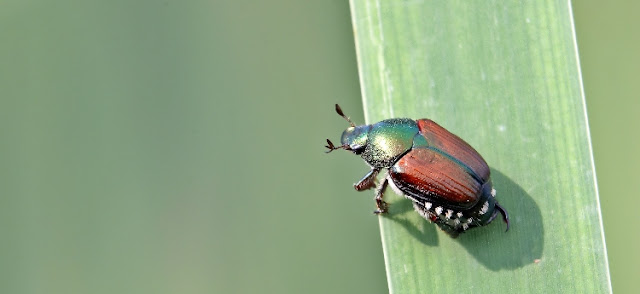
Neighborhoods in Arden-Arcade and Rancho Cordova to be treated

|
| Japanese beetles often are confused with June bugs, which are twice the size. (Photo courtesy California Department of Food and Agriculture) |
Sacramento County is getting the jump on Japanese beetles. Before any new bugs are detected this spring, crews are treating neighborhoods in Arden-Arcade and Rancho Cordova in hope of breaking the life cycle of this highly destructive, invasive pest.
On Monday, Sacramento County announced it would start beetle treatments, the second year of an eradication program triggered by the detection of Japanese beetles in those neighborhoods. Impacted property owners will be notified in advance, the county says.
In past years, a few beetle sightings have triggered quarantines and spraying. But the last two years have brought a bevy of bad beetles.
“ Between June 4, 2020, and Aug. 9, 2021, a total of 231 Japanese beetles were trapped in the communities of Arden-Arcade and Rancho Cordova, Sacramento County,” according to the California Department of Food and Agriculture. “Unless emergency action is taken to disrupt the JB life cycle, there is a high potential for sudden future detections in Sacramento County and other areas.”
With shiny copper-toned wing covers and green heads, Japanese beetles look like little scarabs. They’re small – only 1/3 to ½ inch long – but are often confused with fig beetles or June bugs, which are both about twice the size of Japanese beetles.
So far, California has repeatedly fought off infestations of Japanese beetles, which are well established on the East Coast. But these Sacramento County bugs have been a challenge.
Traps were set out last summer in a 49-square-mile area of Sacramento County to monitor Japanese beetle activity. Instead of numbers going down, they went up.
“ (After review of data), I have determined that an infestation of Japanese beetle exists in the area, and poses a statewide significant imminent danger to California’s commercial fruit and berry production, residential fruit plantings, natural resources, and the economy,” wrote Karen Ross, California’s Secretary of Food and Agriculture.
“ Adults feed on the foliage and fruits of several hundred species of fruit trees, ornamental trees, shrubs, vines, and field and vegetable crops,” Ross said in her declaration. “Among the plants most commonly damaged are apple, pears, caneberries, pears, blueberries, cherries, plums, corn, rose, grape, crabapple, turf grass and beans.”
All that adds up to bad news if these beetles become established in the Central Valley.
Among the worst turf-grass pests, Japanese beetle larvae feed on the roots of lawns. Golf courses, parks and playgrounds are particularly susceptible and can act as nurseries for the baby beetles. The eradication effort includes treating lawns and ground covers with Acelepryn (also known as chlorantraniliprole).
The treatment areas include two islands in Arden-Arcade: An Edison Avenue neighborhood mostly between Becerra Way and Norris Avenue; and a larger area surrounding Watt Avenue from William Way to Marconi Avenue, including all of the Del Paso Country Club.
Likewise, two islands located within Rancho Cordova will be treated: The neighborhood surrounding Corvina Drive near Zinfandel Drive; and neighborhoods on both sides of Highway 50 from Mather Field Road to White Rock Road.
This eradication program is expected to continue through 2024 until state and county officials can determine if Sacramento County is Japanese beetle free.
For more information, contact the Sacramento County agriculture commissioner’s office at 916-875-6603 or CDFA’s Pest Hotline at 800-491-1899.
For details, https://www.cdfa.ca.gov/plant/JB/treatment/
Comments
0 comments have been posted.Sacramento Digs Gardening to your inbox.
Food in My Back Yard Series
May 6: Maintain soil moisture with mulch for garden success
April 29: What's (already) wrong with my tomato plants?
April 22: Should you stock up on fertilizer? (Yes!)
April 15: Grow culinary herbs in containers
April 8: When to plant summer vegetables
April 1: Don't be fooled by these garden myths
March 25: Fertilizer tips: How to 'feed' your vegetables for healthy growth
March 18: Time to give vegetable seedlings some more space
March 11: Ways to win the fight against weeds
March 4: Potatoes from the garden
Feb. 25: Plant a fruit tree now -- for later
Feb. 18: How to squeeze more food into less space
Feb. 11: When to plant? Consider staggering your transplants
Feb. 4: Starting in seed starting
Sites We Like
Garden Checklist for week of May 11
Make the most of the lower temperatures early in the week. We’ll be back in the 80s by Thursday.
* Plant, plant, plant! It’s prime planting season in the Sacramento area. Time to set out those tomato transplants along with peppers and eggplants. Pinch off any flowers on new transplants to make them concentrate on establishing roots instead of setting premature fruit.
* Direct-seed melons, cucumbers, summer squash, corn, radishes, pumpkins and annual herbs such as basil.
* Harvest cabbage, lettuce, peas and green onions.
* In the flower garden, direct-seed sunflowers, cosmos, salvia, zinnias, marigolds, celosia and asters. (You also can transplant seedlings for many of the same flowers.)
* Plant dahlia tubers.
* Transplant petunias, marigolds and perennial flowers such as astilbe, columbine, coneflowers, coreopsis, dahlias, rudbeckia and verbena.
* Keep an eye out for slugs, snails, earwigs and aphids that want to dine on tender new growth.
* Feed summer bloomers with a balanced fertilizer.
* For continued bloom, cut off spent flowers on roses as well as other flowering plants.
* Add mulch to the garden to maintain moisture. Mulch also cuts down on weeds. But don’t let it mound around the stems or trunks of trees or shrubs. Leave about a 6-inch-to-1-foot circle to avoid crown rot or other problems.
* Remember to weed! Pull those nasties before they set seed.
* Water early in the day and keep seedlings evenly moist.